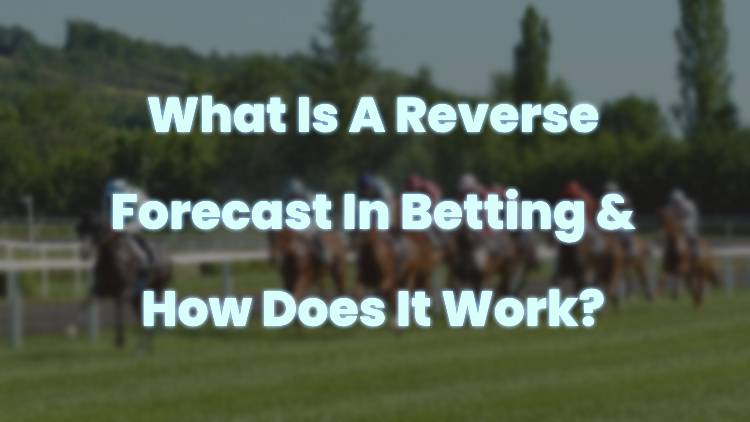
If you enjoy betting on horse racing or greyhound racing, you might have come across the term "reverse forecast". But what does it mean, and how does it work?
A reverse forecast is a type of bet where you pick two selections, and they must finish first and second in any order. This type of bet can add a bit more excitement and flexibility to your betting experience because it provides two chances for a winning combination.
Understanding a reverse forecast can make your wagering more interesting and potentially more rewarding. In this post, we'll explain the basics of reverse forecast betting and guide you through how to place this bet.
So, whether you're new to betting or looking to try something different, read on to learn all about reverse forecasts.
What Does Reverse Forecast Mean In Betting?
A reverse forecast bet is popular in sports like horse racing and greyhound racing. It's a straightforward bet where you pick two runners, and they must finish in the first two positions.
The key detail is that it doesn't matter which one comes in first and which one comes second. As long as the two chosen runners take the top two spots, you win the bet.
Unlike a straight forecast, where the order matters, a reverse forecast covers you both ways. This makes it a bit easier because you don't have to guess the exact positions – just the top two. For example, if you place a reverse forecast on Horse A and Horse B, you will win if Horse A finishes first and Horse B finishes second or vice versa.
This flexibility is why many people enjoy placing reverse forecast bets. It offers a bit more leeway than having to predict the exact order of the finishers.
With a reverse forecast, you are essentially placing two separate forecast bets. Therefore, the cost of a reverse forecast is double that of a straight forecast, but the potential for a win is higher given the two possible outcomes.
How Do Reverse Forecast Bets Work?
Reverse forecast bets are quite simple once you understand the basics.
First, you need to choose two runners in a race. These can be horses or greyhounds, depending on the event you're betting on.
Next, you place your reverse forecast bet. This means you are betting on both possible outcomes: Runner A finishing first and Runner B second, as well as Runner B finishing first and Runner A second. Because you are essentially placing two separate bets, the total cost of a reverse forecast is doubled.
For your bet to win, your chosen runners must finish in the first two positions, but the order doesn't matter. This flexibility gives you a better chance compared to other types of bets that require precise predictions.
If both runners finish in the top two spots, you win, and the payout will depend on the odds of each of your chosen runners.
Understanding how reverse forecasts work allows you to navigate this area of the betting landscape more confidently.
How To Place a Reverse Forecast Bet
Placing a reverse forecast bet is quite straightforward. Here's how you can do it:
- Choose Your Event: First, select the race you want to bet on. This could be a horse race, a greyhound race, or something else.
- Pick Two Runners: Identify the two participants you believe will finish in the top two positions. Remember, the order doesn't matter with a reverse forecast bet.
- Select Reverse Forecast: When you place your bet with a bookmaker, look for the option to place a reverse forecast. This might be found in the betting slip under forecast options.
- Enter Your Stake: Decide how much money you want to bet. Because a reverse forecast is essentially two straight forecast bets in one, it is typically more expensive. So, if you choose to bet £1 on each outcome (each straight forecast bet), it will cost you £2 in total.
- Confirm Your Bet: Double-check your selections and the stake. Once you're sure, confirm and place the bet.
- Wait for Results: Watch the race and wait for the results to come in. If your two chosen runners finish in the top two positions, you win.
That's all you need to do to place a reverse forecast bet.
How Is Reverse Forecast Betting Calculated?
Calculating a reverse forecast bet involves a few simple steps.
First, remember that placing a reverse forecast bet means making two separate bets: one for each possible finishing order of your chosen runners. The total cost of your bet will be double your stake for each individual outcome (each straight forecast). For example, if you bet £1 on each outcome, you'll pay £2 since you're covering both possible results.
If the race finishes and your selections take the top two spots, the winnings are calculated using the odds of both runners. Bookmakers typically use a specific formula to determine the return. They combine the odds of each chosen runner finishing in the top positions in both possible orders.
For instance, if Runner A has odds of 3/1 and Runner B has odds of 4/1, the calculation would involve these odds for both combinations:
- Runner A 1st and Runner B 2nd
- Runner B 1st and Runner A 2nd
The combined odds are then multiplied by your stake to determine your payout.
This might sound a bit technical, but essentially, bookmakers do the hard work for you. They ensure your winnings reflect the chances of both runners finishing in the top two positions, providing you with a fair return on your successful bet.
